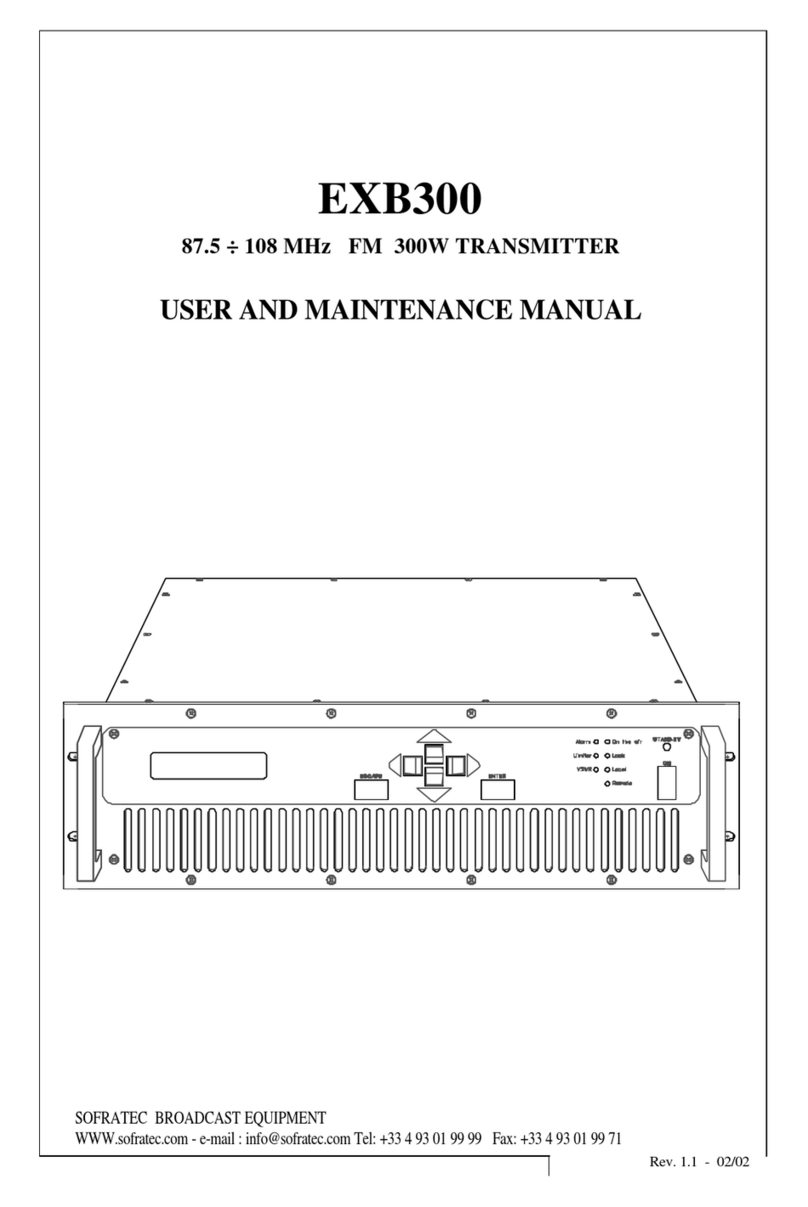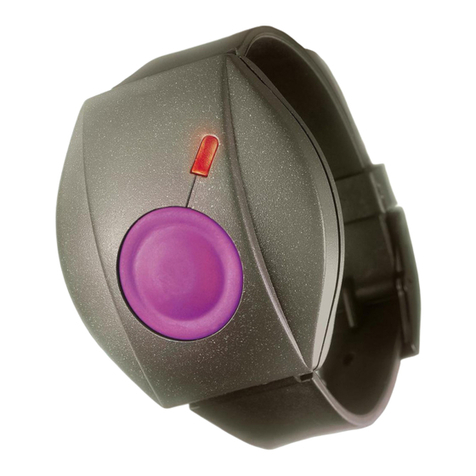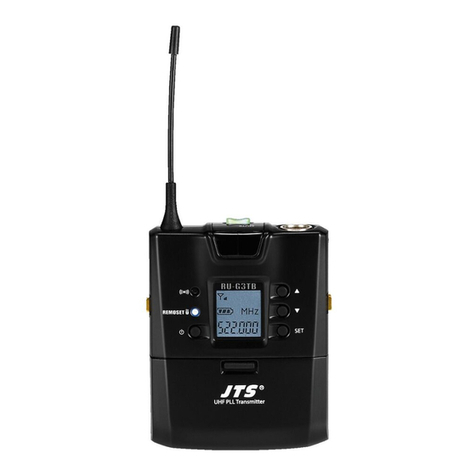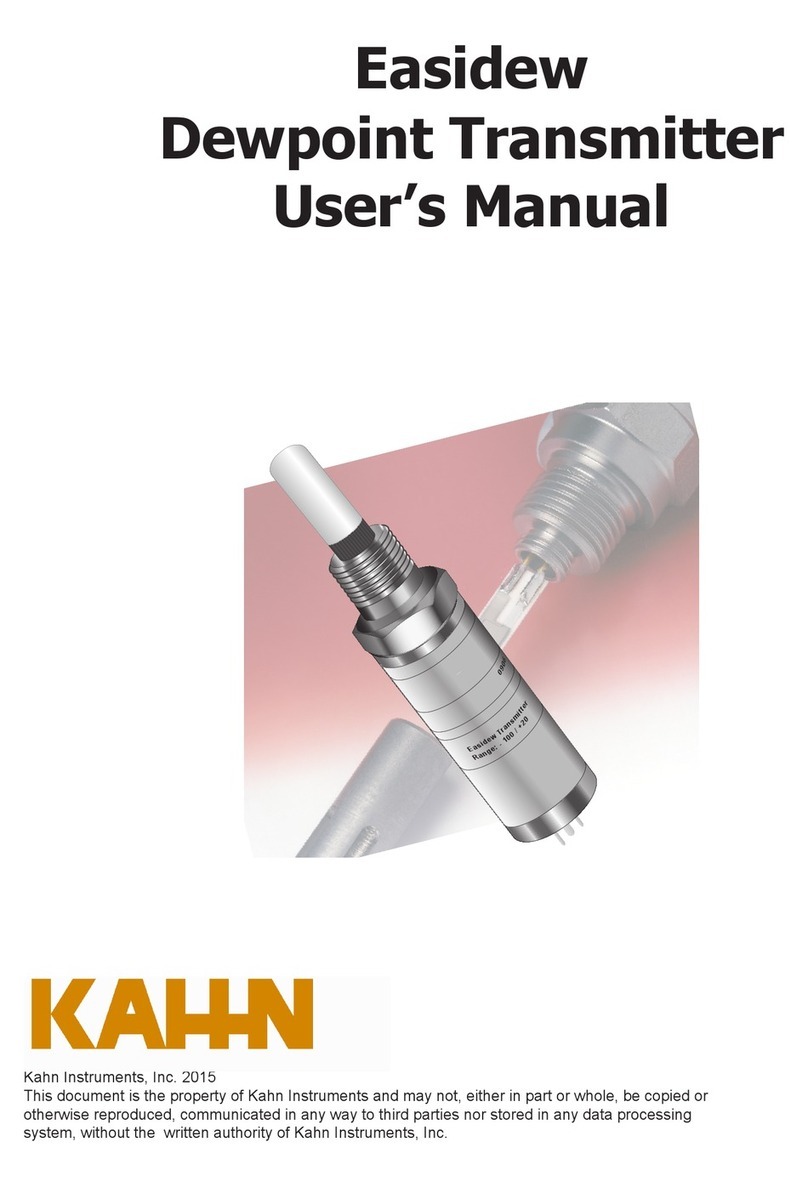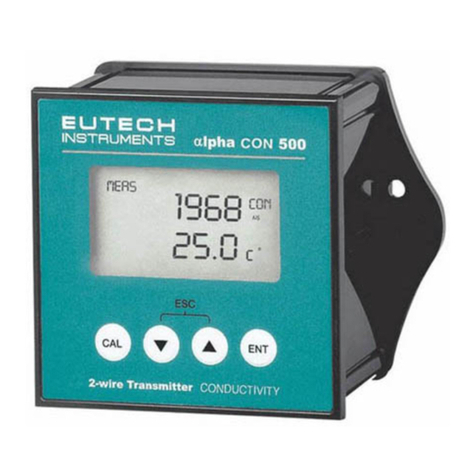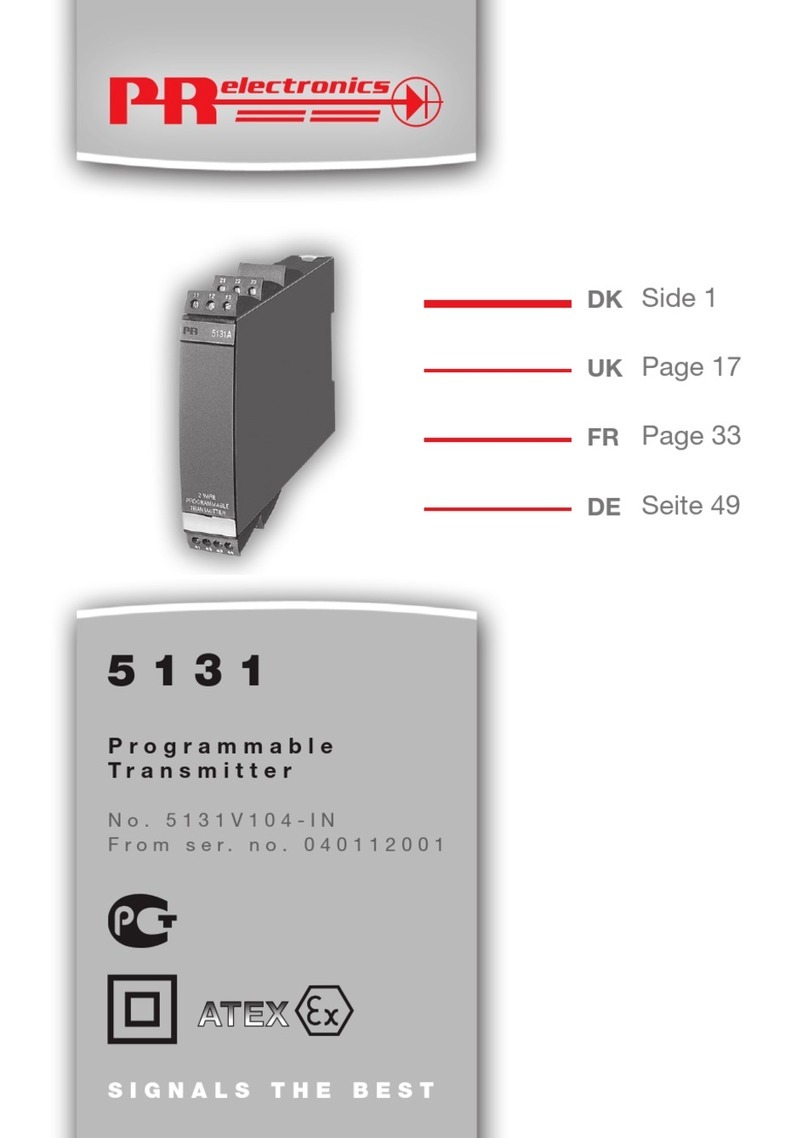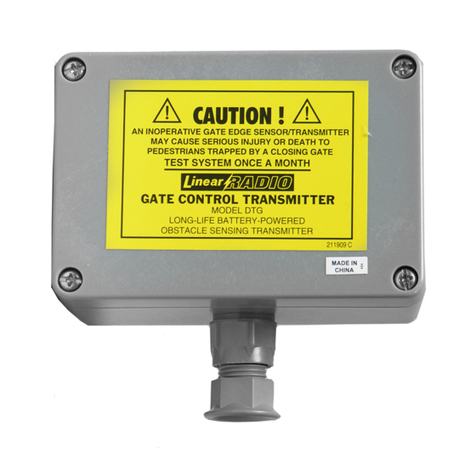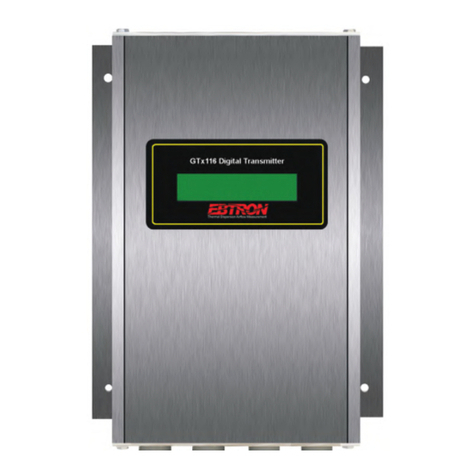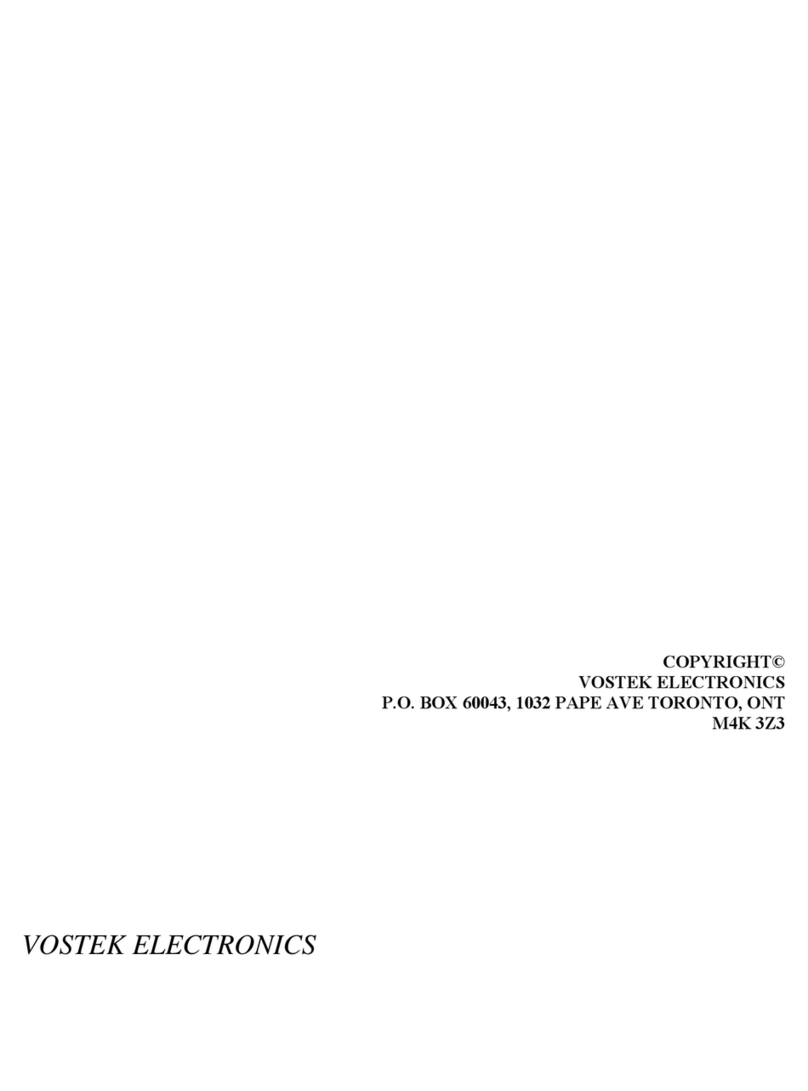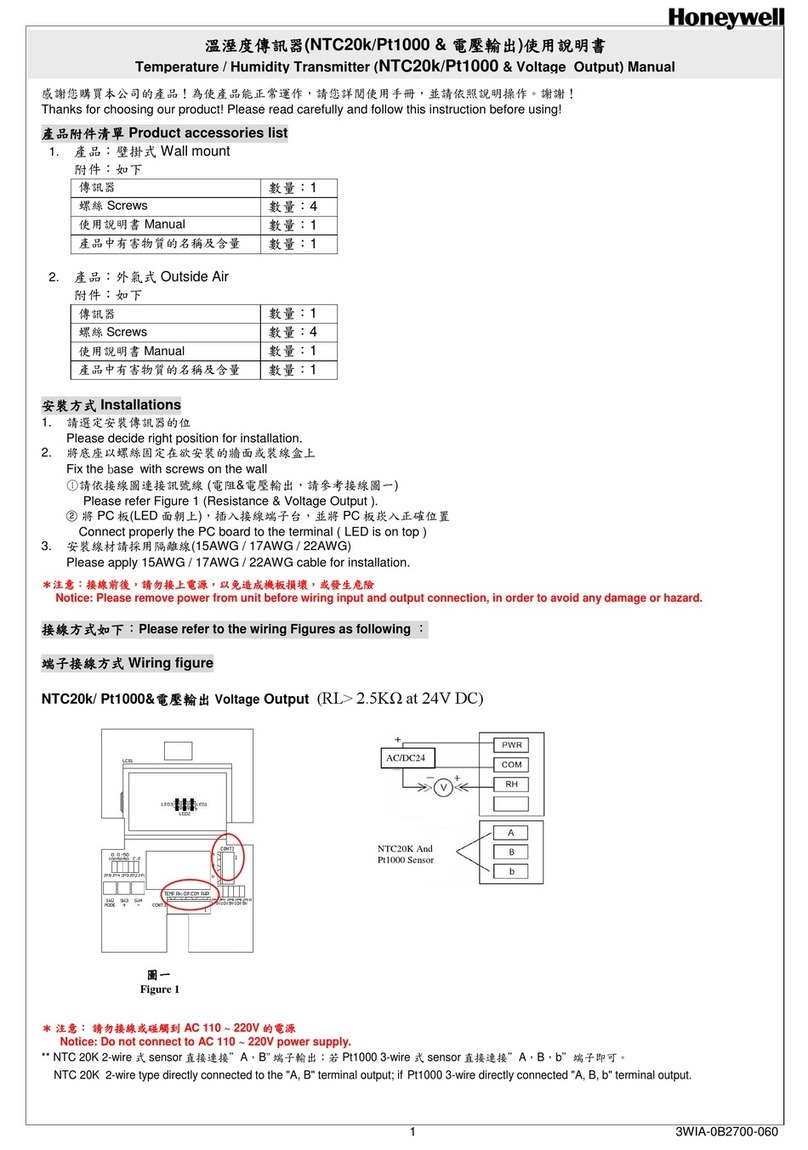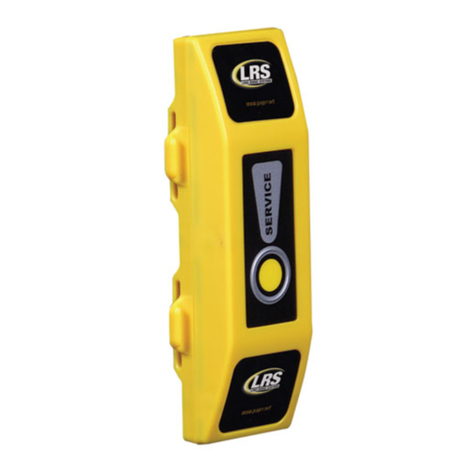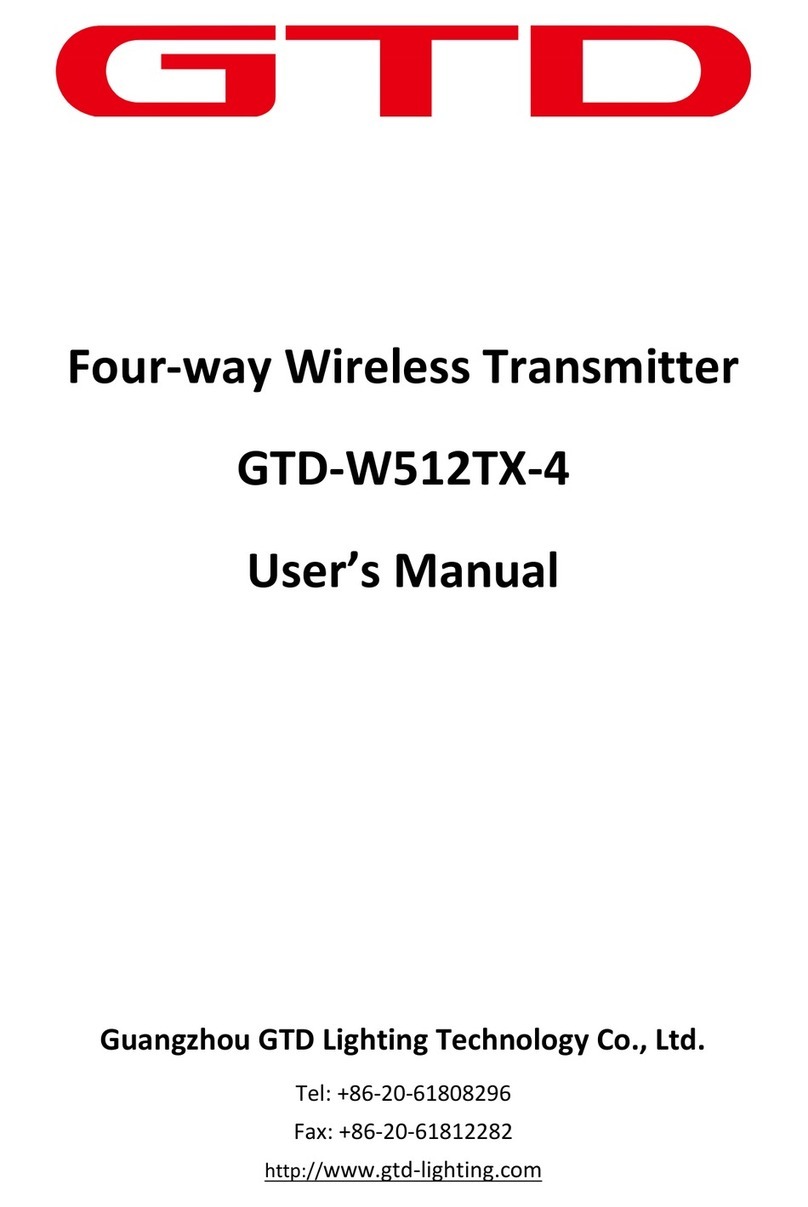Sofratec EB2000 User manual

PAGE 1
SOFRATEC BROADCAST EQUIPMENT
EB 2000 USER AND MAINTENANCE MANUAL
Rev. 2.0 - 06/03
EB2000
87.5 ÷ 108 MHz FM 2000W TRANSMITTER
USER AND MAINTENANCE MANUAL

PAGE 2
SOFRATEC BROADCAST EQUIPMENT
EB 2000 USER AND MAINTENANCE MANUAL
CONTENTS
1INTRODUCTION....................................................................................................3
2GENERAL DESCRIPTION ...................................................................................4
3TECHNICAL FEATURES .....................................................................................5
4TECHNICAL SPECIFICATIONS..........................................................................8
5INSTALLATION AND USE....................................................................................9
5.1 FOREWORD TO INSTALLATION ............................................................9
5.2 PLACING THE APPARATUS ....................................................................10
5.3 WIRING INTO THE MAINS..................................................................... 11
5.4 SYSTEM CONNECTION ...........................................................................12
5.5 LF CONNECTION AND PRESETS ..........................................................13
5.6 OPERATION................................................................................................ 18
6COMMANDS AND PROGRAMMING..............................................................21
6.1 PASSWORD ORGANISATION................................................................. 21
6.2 FACTORY DEFAULT PASSWORDS........................................................22
6.3 MENU AND COMMANDS DESCRIPTION ...........................................23
7SERVICE AND MAINTENANCE .......................................................................33
8GUARANTEE......................................................................................................... 34
9SERVICE MANUAL..............................................................................................35
9.1 INTERNAL DESCRIPTION ......................................................................35
DRAWINGS
EB2000, top & front assembly view
EB2000, rear internal view
EB2000, general electric diagram (E1024)
EB2000, exciter assembly electric diagram (E0909)
SEXC25AL5, auxiliary power regulator board (E0805A)
EXC25CON, cpu controller and display board (E0838)
EXC1K05IN, input & interface board (E0911)
EXC25MB, lf and rf control mainboard (E0837)
SEXC23COD2, stereo encoder board (E0868)
SEXC25MOD, FM exciter board (E0839)
ASEXC25AM5, 25W FM driver amplifier (E0691)
ASRFB2K0RF, 2KW amplifier assembly (E1018)
SRFB2K0LP, 2KW low pass filter (E1017)
SRFB500W, 500Wamplifier module
SRFB1K5ALM, 48V/70A SMPS regulator module
EXB 2000 USER AND MAINTENANCE MANUAL

PAGE 3
SOFRATEC BROADCAST EQUIPMENT
EB 2000 USER AND MAINTENANCE MANUAL
EXC 2005
87.5 ÷ 108 MHz FM 2000W TRANSMITTER
1. INTRODUCTION
TheEB2000 series transmitters are the result ofexperience gained by SOFRATEC during years of
producing FM broadcast equipment, transmitters, stl and stereo encoders.
These transmitters were specifically designed to comply with the latest international standards and
the requirements of advanced broadcasters, meeting tighter specifications than usually required, at an
affordable cost.
Greatcarewentinto besidesthe producingaHi-Fi-qualitymodulatedsignal,withlowresidualnoise
anddistortion.RFsignalisfreefromspuriousandharmoniccomponentstoahigherdegreethanrequired
by CCIR, European, USA and most other national standards.
In order to obtain this outstanding performance, SOFRATEC strongly recommend to rely on
qualified personnel to install and verify the equipment which builds up the radio station, i.e. the
transmitter, the possible stl and power amplifier, the corresponding antennas, cables and connectors.
This will assure the best performance and stability in time.
Tothis aim, we especially recommend thatour equipment should not be tamperedwith by unskilled
personnel and our after-sale service is available to customers for any technical problem. Before
proceeding to the installation, please carefully read at least the general installation part of this manual,
to gain confidence with the equipment.
Thetransmitters areverystable andchangesto theinternalpre-setting otherthanfrequency andfew
other options are not usually required but, if they are, once again we repeat that they must be carried
outbyskilledpersonnel,withtheproperinstrumentsandservicedocumentation.Improperlytampering
with the settings may harm the apparatus or jeopardize the guaranteed performance.
THIS EQUIPMENT COMPLIES WITH ALL RELEVANT EMI/EMC AND SAFETY
REQUIREMENTS, ETSI EN300384, ETS300447 AND EN60215 STANDARDS.
NO INTERNAL ADJUSTMENT OR PRESETTING IS REQUIRED DURING NORMAL
OPERATIONS. THEAPPARATUS SHALLBEPROPERLYEARTHEDANDBEOPERATED
WITH ALL THE COVERS CLOSED TO PREVENT ELECTRICAL HAZARDS AND
COMPLY WITH EMC STANDARDS.
——— MAINS VOLTAGE MAY KILL ———

PAGE 4
SOFRATEC BROADCAST EQUIPMENT
EB 2000 USER AND MAINTENANCE MANUAL
2. GENERAL DESCRIPTION
The EB2000 is a 2000W rated, direct-synthesis, FM-modulated transmitter. Being digitally
controlled,itisextensivelyonfieldprogrammablebyfrontpanelorremotelyineveryrespect:frequency,
power, channel sensitivity, preemphasis, functioning mode (mono, stereo, external mpx), clock and
dateandmanyotherparameterswithoutadjustingorreplacing anypart. Apowerful3-levelspassword
managementpermitsaveryhighdegreeofsecurityandprivacyasmayberequiredindifferentsituations.
The apparatus requires little or no maintenance and its simple modular layout allows easy stage testing
and servicing.
As required by various national standards, these transmitters incorporate sophisticated low-pass
audio filters on mono and stereo channels, and a sharp acting modulation limiter, which is usually set
atapeakdeviationslightlyhigherthan75kHz. Itsinterventionmayneverthelessbeavoided,ifrequired,
by pre-setting its threshold at a deviation higher than 150 kHz.
Output frequency is phase-locked to a temperature-compensated crystal oscillator, which ensures
superior precision and stability. A very low noise, low distortion VCO produces a harmonic-free,
spurious-free signal. A lock control circuit inhibits the presence of power on the output until the
apparatus is on the right frequency, when it is turned on.
Tolowerthenoisethresholdfurther,thelow-frequencyinputsarefittedwithbalancedinputcircuitry.
The input level is precisely adjustable over a broad range, by means of a 0.5dB stepwise variable
attenuators. The transmitter has an auxiliary input, specifically designed for RDS and SCA encoders.
A modulation output permits to control other transmitters or STL's with the same internally processed
high-quality mpx signal.
Thealphanumericdisplaypermitseasyandaccuratemetering,adjustmentandcontinuousmonitoring
ofmodulationlevels,power,operationandinternalparameters.Suchdetailsmaybeexternallyavailable
on the same RS232 I/O port that may be used to remotely control the transmitter. In addition to the
serialI/O,somesignals(RFpower,Ontheairstate,Disableline)areavailableonaparallelI/Osocket
for easy interfacing with others analog controllers or supervisory systems.
Atop-qualitystereoencodermaybefactoryinstalledasoptionandevenretrofittedlaterinthefield,
requiring minimum technical skill. The powerful internal software and monitoring functions recognise
its presence and enable its functions.
The RF power amplifier employs a broadband design and has plenty of reserve: the output power
isfeedackcontrolledforincreasedstabilitytoahigherlevelthanthenominal one.High reflectedpower
is limited to prevent output stage degradation; direct power is accordingly continuously reduced so as
not to exceed the reflected power safety level. A sturdy telecom-grade high efficiency switch-mode
power supply permits operation in a very wide and noisy mains environment.
The temperature alarm circuitry reduce the output power in case of high room or esternal
temperature, trying to stay on the air in spite of the adverse conditions.

PAGE 5
SOFRATEC BROADCAST EQUIPMENT
EB 2000 USER AND MAINTENANCE MANUAL
3. TECHNICAL FEATURES
3.1 FRONT PANEL COMMANDS AND SIGNALLING
The EB2000front paneliscleanandeasytocontrol.Thewidealphanumericdisplayandthecontrol
keyboard permit a simple self-explanatory menu-driven navigation through the various options.
Great care was taken in the design of the software to allow a natural approach to the controls and
allow operationandprogrammingineveryrespectoftheapparatuswithoutneedingtoextensivelyread
the user's manual.
The password management, hides some functions and prevents tampering with the most critical
options and data to unauthorised people.
Theon/stand-bykeydoes notpowerofftheapparatus,whichisstilllockedonfrequencyandready
to transmit as soon as the key is pushed or a remote command is sent.
Some leds signal at a glance proper functioning and warning states.

PAGE 6
SOFRATEC BROADCAST EQUIPMENT
EB 2000 USER AND MAINTENANCE MANUAL
INCASEOFDUCTINGOFTHEVENTILATIONAIR,
AN EXTERNAL EXTRACTING FAN IS REQUIRED.
LEFT
AUDIO INPUT
RIGHT REMOTE
2 Signal -
1 Ground
3 Signal +
2
3
1
20k-100k
MODULATION
MONITOR RS232AUX MPX
10-100000 Hz
RFOUTPUT
50 OHM
MADEINITALY
0678
ABSOLUTELY REMOVE POWER CORD FROM MAINS
GROUND
UPPER AND BOTTOM COVERS ARE REQUIRED TO
ELECTRICAL SHOCKS, DO NOT REMOVE ANY PANEL.
MEET BOTH SAFETY AND EMI REQUIREMENTS.
CIRCUITSATTHEREAROFTHISPANELARE
CONNECTED TO MAINS VOLTAGE. TO PREVENT
CAUTION!
POWER
ON
I PANNELLI DI CHIUSURA SUPERIORE ED INFERIORE
PRIMA DI CAMBIARE I FUSIBILI INTERNI, DISCONNETTERE
SONO RICHIESTI PER LA CONFORMITA' AGLI STANDARD
DISICUREZZAE DI EMISSIONE ELETTROMAGNETICA.
ASSOLUTAMENTE IL COLLEGAMENTO ALLA RETE
NON RIMUOVERE LE COPERTURE. INOLTRE ENTRAMBI
RETE. PER EVITARE RISCHI DA SCOSSA ELETTRICA
SULRETRODIQUESTOPANNELLO SONO DIRET-
TAMENTEACCESSIBILICIRCUITI A TENSIONE DI
BEFOREREPLACING INTERNALFUSES.
ATTENZIONE!
E' RICHIESTO UN GRUPPO DI ASPIRAZIONE ESTERNO.
IN CASO DI CONVOGLIAMENTO DELL'ARIA DI VENTILAZIONE
4500VA (RFB2001)
230Vac 50/60Hz
2500VA (RFB1001)
OFF
0678
SISTEMI
ELETTRONICI
INCASEOFDUCTINGOFTHEVENTILATIONAIR,
AN EXTERNAL EXTRACTING FAN IS REQUIRED.
LEFT
AUDIO INPUT
RIGHT REMOTE
2 Signal -
1 Ground
3 Signal +
2
3
1
20k-100k
MODULATION
MONITOR RS232AUX MPX
10-100000 Hz
RFOUTPUT
50 OHM
MADEINITALY
0678
ABSOLUTELY REMOVE POWER CORD FROM MAINS
GROUND
UPPER AND BOTTOM COVERS ARE REQUIRED TO
ELECTRICAL SHOCKS, DO NOT REMOVE ANY PANEL.
MEET BOTH SAFETY AND EMI REQUIREMENTS.
CIRCUITSATTHEREAROFTHISPANELARE
CONNECTED TO MAINS VOLTAGE. TO PREVENT
CAUTION!
POWER
ON
I PANNELLI DI CHIUSURA SUPERIORE ED INFERIORE
PRIMA DI CAMBIARE I FUSIBILI INTERNI, DISCONNETTERE
SONO RICHIESTI PER LA CONFORMITA' AGLI STANDARD
DISICUREZZAE DI EMISSIONE ELETTROMAGNETICA.
ASSOLUTAMENTE IL COLLEGAMENTO ALLA RETE
NON RIMUOVERE LE COPERTURE. INOLTRE ENTRAMBI
RETE. PER EVITARE RISCHI DA SCOSSA ELETTRICA
SULRETRODIQUESTOPANNELLO SONO DIRET-
TAMENTEACCESSIBILICIRCUITI A TENSIONE DI
BEFOREREPLACING INTERNALFUSES.
ATTENZIONE!
E' RICHIESTO UN GRUPPO DI ASPIRAZIONE ESTERNO.
IN CASO DI CONVOGLIAMENTO DELL'ARIA DI VENTILAZIONE
4500VA (RFB2001)
230Vac 50/60Hz
2500VA (RFB1001)
OFF
0678
SISTEMI
ELETTRONICI
3.2 REAR PANEL CONNECTORS
All transmitter inputs and outputs are allocated on the rear panel. They are:
-The audio channels input sockets on balanced female XLR-type connectors
-The wide-band external processed / stereo or composite signal input on a grounded
unbalanced BNC connector
-The frequency limited (20k
÷
100kHz) auxiliary channel input on a grounded,
unbalanced BNC connector
-The LF modulation output for monitoring, RDS external synchronisation or re-
broadcasting purpose, BNC-type
-The inverted wired RS232 DB9 female remote serial control port
-The remotr parallel control port, DB9 male type
-The RF antenna connector, N-type
-The hot centre-pin on the "EXTERNAL" BNC input is physically in parallel with the
signal + input (pin 3) on the mono/right channel XLR socket. For this reason both
connectors cannot be used at the same time.
On the left side of the panel it is located the mains power switch, the power cord and
anearthscrewforsystemearthinginadditiontothegroundconductoronthecord.The
power switch trips if an overcurrent condition should occur.
Please note that the transmitter is usually factory pre-set for 220-240 Vac
nominalmainsvoltage. Ifrequested,110-120 Vacrangemust beinternallyset
on the mains tranformer board.

PAGE 7
SOFRATEC BROADCAST EQUIPMENT
EB 2000 USER AND MAINTENANCE MANUAL
Note that:
- The hot centre pin of the "EXTERNAL" BNC input (MPX or stereo inout) is physically parallel to
the "+ input" signal (pin 3) on the mono/right channel XLR socket. For this reason, you cannot use
both connectors at the same time.
On the left side of the panel are located the mains power switch, the power cord and an earth screw
for a separated earthing system as well as the ground conductor on the cord. Should an over-
current condition take place, the power switch would trip and stop the device.

PAGE 8
SOFRATEC BROADCAST EQUIPMENT
EB 2000 USER AND MAINTENANCE MANUAL
4. TECHNICAL SPECIFICATIONS
-Frequency range: 87.5 ÷ 108 MHz
-Modulation: FM, 75 kHz peak deviation:
180k F3E mono
256kF3E stereo
-Passo di sintesi:10/100 kHz
-Frequency error: <200 Hz
-Frequency drift:
<250 Hz in operating temperature
<100Hz/year
-RF output power: 300 ÷ 2000W ± 0,5 dB
-Max reflected power: 160W
-Harmonic products RF: <-67 dB, -72dB
-Spurious products RF: <-85 dB (- 95 dB)
-RF output power impedance: 50 ohm
-RF output power connector: 7/16”
-Audio/Mpx input level: -3.5 ÷ +12.5dBm
@ ± 75kHz deviation
-Audio/Mpx input impedance:
10k ohm/600 ohm, balanced./unsbalanced
-Common mode input:
>50 dB, >60dB tip. (20÷15000 Hz)
-Audio input connectors: XLR female
-Auxiliary/Mpx input level:
-12.5 ÷ +3.5dBm @±7.5 kHz dev.
-24 ÷ -8dBm @±2 kHz dev.
-Aux channel input impedance: 10k ohm
-Mpx and aux input connectors: BNC
-Mpx output level:
0 ÷ +10 dBm @ ±75kHz dev.
-Preenphasis time costant: 0/50/75 µs ±2%
-S/N ratio, mono:
>70 dB, 73 tip. (30÷20000Hz)
-S/N ratio, stereo:
>66 dB, 68 tip. (30÷20000Hz)
-Modular distortion:
<0.05% 0.02% tip. @ 75kHz dev.
<0.2% 0.05% tip. @ 150kHz dev.
( limiter threshold>150 kHz)
-Stereo crosstalk:
>50 dB with ext. encoder
>60 dB (100÷5000 Hz)
>50 dB (30÷15000 Hz)
with int. encoder
-Audio channels frequency response:
30 Hz ÷ 15 kHz ±0.1dB
-Attenuazione fuori banda audio:
>50 dB @ F≥19 kHz
-Deviation limiter: adjustable betw. 0 > +7 dB
-Mpx input frequency response:
10 Hz÷100kHz ±0.1dB
-Aux input frequency response:
10÷ 100 kHz ±0.2dB
-I/O liner: Disable RF, Forward power
On-the-Air, Allarm.
RS232 for monitoring control
-Mains supply requirements:
230 Vca ±15% 50/60 Hz
4800 VA/3600W @ 2000 W output
-Operating temperature range:
0÷35° C recomm.
-10÷45 °C max.
-Dimensions without handless:
483 x 310 x 570 mm
rack std. 19” 7 u
- Weight: ca. 47 Kg
SYSTEM AND PROTECTION CONTROLS
-Block against emission on spurious frequencies
-Reflected power and over temperature
-Modulation limiter
>75 dB, 78 tip. (CCIR)

PAGE 9
SOFRATEC BROADCAST EQUIPMENT
EB 2000 USER AND MAINTENANCE MANUAL
I
5. INSTALLATION AND USE
5.1 FOREWORD TO INSTALLATION
Although in most cases no special instruments are required, have skilled personnel install the
apparatus.Tomakebestuseoftheapparatus’scapabilitiesandpreventdamagetotheunit,complywith
the recommendations throughout this manual.
When in doubt, or if any technical problems should arise during the installation procedure,
SOFRATECstronglyrecommendtheapparatusnotbetamperedwithinanywaybyunskilledpersonnel
and will be glad to supply qualified after-sale service.
TheEB2000 hasmanyfeaturesofahi-fiapparatusandshouldbeinstalledandaudio-wiredwith the
same care, avoiding earth loops as much as possible. When these conditions are met, the transmitter
performs superbly.
As a rule, the user should not have access to the inside of the apparatus for normal installation and
use. Tampering with the factory settings makes the guarantee null and void and might also affect
apparatus’ performance, causing costly damage.
Beforeproceedingfurther,makesurethatmainsvoltagecorrespondstothefactory-setvalue(usually
220/240 Vac). In case it differs, jumpers must be internally set on the mains supply termination board
of the apparatus as described further on the manual. This must be done by skilled technicians.
NO ADJUSTMENT OR INTERNAL PRESETTING IS REQUIRED FOR NORMAL
OPERATIONS. THEAPPARATUS SHALL BE PROPERLYEARTHEDANDBEOPERATED
WITH ALL THE COVERS CLOSED TO PREVENT ELECTRICAL HAZARDS IN
OPERATION AND FULLY COMPLY WITH CE EMI AND SAFETY REQUIREMENTS.
NEVER TOUCH THE INSIDE OF THE APPARATUS WITHOUT FIRST DISCONNECTING
IT FROM THE MAINS. DANGEROUS AC, DC AND RADIO-FREQUENCY VOLTAGES
ARE PRESENT INSIDE AND BECOME ACCESSIBLE WHEN THE COVERS ARE RE-
MOVED.
——— MAINS VOLTAGE MAY KILL ———
WARNING !

PAGE 10
SOFRATEC BROADCAST EQUIPMENT
EB 2000 USER AND MAINTENANCE MANUAL
5.2 PLACING THE APPARATUS
Install apparatus in a dry, sheltered but well-ventilated room away from dust, moisture,
insects and vermin (mice). Place apparatus as close as possible to the antenna to prevent
excessive power loss in the cables. If this is not feasible, use antenna cables of suitable cross-
section.
Room size shall be such that the apparatus can be placed in an upright position and that
technical personnel can easily carry out routine or extraordinary maintenance. The minimum
recommendedsizeis2.5mx2m,and2.2mhighwhenthereisnootherbroadcastingorsupport
equipment nearby.
For the best results the operating temperature must be comprised in the +10 ÷ +35 °C
range. Higher temperatures up to +45 °C, while allowed in the specifications, are not
recommended as they will reduce the life of the apparatus.
This conditions cannot generally be met when the exhaust cooling air is not ducted outside
and is fed back into the room. This is even truer if more than one apparatus is installed in the
same location. An efficient ventilation system is thus required in the room. Air exchange in the
room shall have a minimum flow-rate of 500 metres cubed per hour or more.
If the apparatus is fitted in a rack system, the back door of the rack cannot usually be fixed
in place. If a completely closed assembly is needed, a suitable ventilation extraction unit must
equip the system. To aid air ducting, an optional flange may be retrofitted on the ventilation
outlettowhich a duct can be attached to convey hot air outside.Inthiscaserememberthatthe
EB2000 internalfansarelow-pressureunits:somesortofexternalairextractionbloweristhan
imperative on the exhaust air duct.
Ventsinthewalls andanyother openingsshallbefittedwith ametalgratingtokeep rodents
out, and with a dust filter. Make absolutely certain that no water can seep through the vents
or the air exhaust duct or antenna-cable grommet, and that the floor cannot be flooded during
heavyrainfall.Ifnotimpeditedbyproperairfiltering,insectsinsomelocationmaybeconveyed
in the internal heatsink, accumulating on it and finally obstructing it, causing overtemperature
alarm.
Even moisture and/or dust, when contained in the air or in the room in excessive quantity,
maycausecondensationbuild-upintheamplifier.When thesystem isperiodicallyswitchedon
and off, this can trigger destructive electric arcs and short circuits and thus cause damage that
is not covered by the guarantee.

PAGE 11
SOFRATEC BROADCAST EQUIPMENT
EB 2000 USER AND MAINTENANCE MANUAL
I
5.3 WIRING INTO THE MAINS
Thetransmitterispoweredbyasingle-phaseline.Mainscapacitymustbeatleast3kVAandthenominal
voltageis 230Vac.Insomecountries, where 115Vac is the norm, thisvoltagemustbe internally set
in the factory or by skilled people before installation. When both the the mains voltages are
available, always prefer the higher one, to decrease the power loss on the mains line.
The apparatus is now working in the pre-set mode, delivers power and can be accessed to be
programmed or simply to monitor its functions through the keyboard and the front panel display.
The first request at the turn-on will be entering the password for the required level of
authorisation/security.Theapparatusisfactorypre-setwiththefirst2levelsdisabled:thiswill
permittosetmostoftheoperatingparameters,includingpower,frequency,inputlevels,clock
and date. Some more critical parameters will require the upper 3rd level: be sure to know it
if you need this access.
In case the passwords are disabled as factory preset, repeatedly press "ESCAPE" key to access to
keyboard functions
THE TRANSMITTER WILL ALWAYS TURN-ON IN THE SAME STATE AS IT WAS IN
THE LAST TIME IT WAS TURNED OFF FROM MAINS, I.E. POWER, FREQUENCY AND
EVENONORSTAND-BYCONDITION.WHENYOUTURNONTHEREARPANELMAINS
SWITCH, EVEN IF THE APPARATUS IS JUST FACTORY DELIVERED, BE READY FOR
THIS EVENT.
WARNING!

PAGE 12
SOFRATEC BROADCAST EQUIPMENT
EB 2000 USER AND MAINTENANCE MANUAL
5) Turn on the rear panel mains switch, then turn on the front panel on/stand-by switch to operate the
transmitter and check that:
-All leds and the display briefly light on and off for the initial check.
-Theyellow"STAND-BY"ledturnsoff,whilethe"ON"greenledonthecapofthestand-byswitch,
turns on.
-The green "Local" led must light up immediately and the upper green “Lock” led must also light
up after some seconds, when the frequency is locked.
-When locked the RF power will rapidly increase to the pre-set level in a mild ramped mode
-When the preset power is reached, the "On the air" led will light completely, if the power is set
>50W. Till that moment it will turn off and on, signalling that the RF power is on but notcorrect.
Whilstthepowersupplyregulatoracceptsawideinputvoltage(190÷250Vac),operationnearthelower
inputvoltageonhighimpedancelinesmustbe avoided:ifthelinedropsmorethan10volt atfull load,thelow
line sense circuitry may trigger an oscillating turn-on / turn-off cycle, which is very dangerous. In this cases
adopt an external line stabiliser.
To allow nominal 115V mains operation (100 ÷130 Vac), some jumpers must be properly set on the
input transformer terminal board, inside the apparatus. To do that, the power cord must be disconnected
from the mains, the top cover must be removed and the transformer voltage terminals must be accessed.
5.4 SYSTEM CONNECTION
1) Connect the N-type output connector, marked “RF OUT” to the antenna or successive RF amplifier
with top-grade 50-ohm shielded cable.
Low-attenuation type cable must be used for antenna connection: in this case we suggest Celflex or
similar 1/2" cable. Bigger cables must be connected with smaller section pig-tails, to avoid mechanical
stress on the output connector.
2) Connect the LF inputs as required for operation and detailed in the following chapters for various
situations.If needed wiretheserial and/or parallelremotecontrol I/O portsasrequired,or skipthisstep
to a subsequent moment.
3) Turn off the mains rear switch and connect the transmitter to the mains and to the ground system.
4) Before turning on the transmitter set if possible frequency and power separately on a dummy load, in
order to avoid system problems at the first turn-on of the equipment. Refer to the appropriate
programming section of this manual for the procedure, if not known.

PAGE 13
SOFRATEC BROADCAST EQUIPMENT
EB 2000 USER AND MAINTENANCE MANUAL
6) Thefirsttasktomanagewhenturningontheapparatusasfactorydeliveredistoenter thepasswords.
Atleast the3rd(the highest)levelmust beimmediatelychanged:ifanyunauthorisedpeoplechange
it or you loose it, there is no way to change it for security reasons and the apparatus may become
unmanageable. Gaining again access to the apparatus will require factory reprogramming
or changing of the internal CPU.
For this reason be sure to write down and keep itimmediately in a secure place: thereis noway
to read it after you have programmed down and confirmed it.
For practically any parameters that may require some setting in the field, the 2nd level password is
enough and may be used for any standard service requirement. The main purpose of the existence
of the 3rd level is a security assurance for the user in case he loses control on the lower password
levels and wants to gain it back.
7) If not already done, adjust frequency and RF power as required and check reflected power on the
transmitterdisplay.TothisaimsearchforRFpowermenuandreadthecorrespondingvalueofdirect
and reflected output power.
For proper operation, the reflected power reading should typically be less than 10% of the direct
powervalue,100Wmax. Anyhigherreadingmayindicatethat theantennaortheoutputconnectors
are not properly connected or functioning.
8) Checkand/orsetclockand data and all transmission parameters as required, i.e. channel sensitivity
and deviation, mono/stereo, preemphasis etc. Refer to the appropriate section of the manual.
5.5 LF CONNECTION AND PRESETS
LF wiring and impedance selection
EB2000 supports balanced or unbalanced signals with selectable input impedance.
The audio inputs are basically balanced and have selectable 600/10k ohm resistive impedance,
which generally factory pre-set at 10k ohm. They can be connected to the balanced output of
a professional mixer or to the unbalanced one of a cheaper unit without appreciable degradation.
Selection of the input impedance is one of the very few pre-sets that may be done only internally.
For this purpose you must gain internal access by removing the upper cover. To avoid any risk,
removemainsconnectionbeforedoingit.16Phillipsscrewsmustbeunscrewedtoremovethecover.
Be sure to put them back into their place again when done, for EMI/EMC and safety compliance.
Pre-setof input impedance is easily doneby accordingly selecting the jumpers JP1and JP2 located
ontheinputboardjustontherearoftheinputconnectors,asshownonthepreviousdrawing.Impedance
selection is silk-screened on the component mask of the board.
LF audio mono or stereo inputs are “XLR” female connectors. They should be connected to the
outputofthe mixing table, or of any audio-processorthatdrivesit, abalancedcoaxial cable connected
to pin 3 (+) and pin 2 (-). The cable shield, connected to the ground through of the driving equipment,
has to be connected to pin 1.

PAGE 14
SOFRATEC BROADCAST EQUIPMENT
EB 2000 USER AND MAINTENANCE MANUAL
In case of unbalanced drive, input pin 2 shall be short-circuited with ground and shield on pin
1, whilethesignalshallbeavailableonpin3.Higherimpedanceselection,inthiscase,willbe5kohm
instead of 10 kohm.
With balanced drivings signals, the
connecting canles to the audio source may be
far longer than 100-m.
Mpx or an externally processed signal,
usually an unbalanced one, can be connected
tothefemaleBNCconnector,marked"MPX",
whichisinternallyparallelwiredtothe"RIGHT"
channel connector: for this reason it is not
possible to connect signals to these two
connectorsatthesametime. Higherimpedance
position is 5 kohm in this case too.
If the distance exceeds several tens of
metres, use 75-ohm (RG59) or 92-ohm
(RG62) cables.
The auxiliary-channel connector is also of
the grounded BNC female type. Use 50-ohm (RG58) or 75-ohm (RG59) cables for the connection
to the driver. The same applies to the monitor "MODULATION" output, if needed.
Pre-emphasis setting
Low frequency mono and stereo channel signals have to be adequately “pre-emphasised”.
Standardpreemphasistimeconstantis50and75µs,theformerbeingusuallyfactorypre-set. Check
whetherthisiscorrect for your country (it is usually correct foranyEuropeancountryand most of the
Pacific and South American areas). It is not correct for USA standards, which require 75µs.
If above correction is needed, simply set it on the "mode" FCC frame of the transmitter menu,
which also includes mono/stereo operation and frequency. See appropriate section further on in this
manual.
LF input level range, setting and requirements
Inthefollowingparagraphwewillreferto0dBmastheaudiosignalwhichproduces1mWon600
ohm, i.e. a 775 mVrms / 2200 mVpp sine. Irrespective of the impedance and the non-sinus form
of the signal, we will continue to assume 0 dBm as a LF signal whose peak is + (or -) 1100 mV.

PAGE 15
SOFRATEC BROADCAST EQUIPMENT
EB 2000 USER AND MAINTENANCE MANUAL
In the same way, when talking of the modulation, we will generally assume 0 dB as the signal which
produces 100% maximum allowed modulation, i.e. 75 kHz deviation.
There is no absolute worldwide standard regarding LF peak level as modulation signal for a
transmitter,norforthemeandeviation. Manybroadcastersuse0or+6dBmasLFpeaklevelfor100%
modulation, USA often uses +10 dBm.
Many European countries specify +6dBm for 40 kHz deviation (which is assumed to be a "mean"
modulation). This allows 5.5 dB headroom to 75 kHz (max) deviation, i.e. +11.5 dBm for 100%
modulation.
Ahigherlevelminimisesystemandambientnoise. A toohigh levelmayover-stresstheinputcircuitry
ofthetransmitter,reducingthedynamicdistortion-freerangeoverthenominallevel(headroom). Itmay
also be costly to produce a broad sygnal with the required quality.
ForthisreasonSOFRATECrecommend,wheneverpossible,toadopt+6÷+11.5dBmasnominal
peak level for audio modulation purpose.
EB2000 transmitter series allows to set a "variabile" LF level on the main channel/s ranging -3.5 ÷
+12.5 dBm to be set for 100% modulation, with almost no difference in modulation performances, if
highqualitysignalisprovided. Evenatthehigherlevel,atleast+6 dBheadroom isadditionallyallowed:
i.e.upto150kHzdeviation,withnodistortion. Obviouslythisdeviationisnotallowedbyanybroadcast
standard and the limiter threshold in this case should be set at its maximum to permit undistorted
performance.
The auxiliary channel’s level ranges -12 ÷ +4 dBm to produce 10% modulation, i.e. 7.5kHz
deviation. Consequently typical input levels for an SCA-type signal (10% max. admissible deviation)
are 0.2 ÷ 1.0 Vrms / 566 ÷ 2830 mVpp, when the input is set between -11.5 and +2.5 dB. All the same,
an RDS-type signal could be accommodated in the 0.052 ÷ 0.33 Vrms / 150 ÷ 930 mVpp level range,
to produce the standard peak deviation of 2 kHz, as above. In case a higher deviation is required for
RDS (some broadcast authorities set it to 3 or even 4 kHz deviation instead of the standard 2kHz )
a higher signal level preset sensitivity of the auxiliary input, is needed.
Regulating the nominal input level for 0 dB modulation on the transmitter is an easy task. From the
propermenufieldyou can see the variation in real-time, while theinputlevelisbeing adjusted, in 0,5dB
steps. The modulation is reported in kHz as absolute deviation, and in dB with reference to 75kHz.
In this field, the reported deviation includes any other auxiliary signal as pilot tone, when in stereo,
and RDS or SCA signals, if used at the moment. To measure only the audio input channel signal, go to
the Left/Right level menu.
Theauxiliary channel levelisequally easy toset,being measured assensitivityindB andasdeviation
inkHz. Remember that, in thiscase,0dBcorrespondsto 7.5kHz deviation, i.e. 10%maxallowedtotal
standard modulation. In this way the typical level for RDS is -11.5dB for 2 kHz deviation. This menu
field accounts only for deviation due to auxiliary signal. To see the added effect on the total deviation,
go to the MPX menu.
Due tothepeculiarcharacteristicsoftheRDSsignalandthemeasuringsampling,thereading
is slow to stabilise in case of sudden level variarions and tends sometimes to slightly flicker in
few tenths of a dB. Allow enough time to stabilise and take the higher deviation reported as the
right one.

PAGE 16
SOFRATEC BROADCAST EQUIPMENT
EB 2000 USER AND MAINTENANCE MANUAL
Thetransmitter’sinternallimiterisofthepeak-clippingtype;thismeansthatassoonatitcuts
in,modulationdistortionincreasessharply.Forthisreason,themodulationsignalshouldbekept
under control to prevent intervention of the limiter. Do not over-estimate this problem:
occasional action of the limiter is mostly unperceivable.
The cut-in limiter threshold, when enabled, is factory pre-set to +2.5 dB (100 kHz peak
value). It may be set from 0 dB (75 kHz) up to +7.1 dB (170 kHz). This threshold value is
mostlyspecifiedinthevariousnationalstandards,andtolerancetoshortover-modulatingpeaks
varies from country to country. Some countries do not permit the user to disable the limiter or
change the level. Some countries do not allow the user to disable the limiter or change its
threshold. Note that the limiter action begins slightly after the pre-set level,with no action at all
till that. The difference between the threshold level and hard clipping is some 0.5dB.
In any case, the modulation peak value that is internationally admitted for FM is 75 kHz for
peaks that are not extremely short. For this reason, the limiter’s cut-in threshold should never
be too high. It is highly recommended to use an external multi-band limiter to optimise
modulation,withhighertoleranceforanyaudio-signalpeaks.Suchdevicesmomentarilyreduce
theamplifier circuits’gainifthe thresholdisexceeded and preventsevere,significant distortion.
Anyexternal compressor, limiter or audio metermust be frequency compensated with the
same time constant of the pre-emphasis to modulate or monitor deviation properly.
Therefore the audio level shall be constantly and correctly monitored and adjusted to
prevent, as much as possible, the internal limiter from cutting in. Besides the audio level should
be as high as possible, to achieve the best signal/noise ratio on reception.
Thetendency to over-process audio signals iscommoninmanylocalbroadcastingstations:
some sort of processing is advisable and we recommend using a top grade multiband
compressor, but not to compress the signal too much as this impairs the original dynamics.
TheaudioresponseoftheEB2000transmitterisextremelyflat,withoutanyperceivableloss
on lowandhigh audiofrequency: forthis reason largefrequencyalterationsofthe audio signal
supplied by using a so-called “frequency equaliser,” are not advisable. An increase of the low
and high frequency contents of the audio signal by more than a few dB can cause general
degradation of modulation dynamics and improper functioning of the limiter.

PAGE 17
SOFRATEC BROADCAST EQUIPMENT
EB 2000 USER AND MAINTENANCE MANUAL
RS232 port
TheRS232portmanagesonlyTx,RxandReturndatasignals,withnohandshake.Beingthe signals
"inverted wired", you only need a simple serial cable of the pin-to-pin type, directly wired to the
suitable connectors - usually female DB9 or DB25 - which must be connected to a PC port. Besides,
you need a male connector - DB9 type - to be wired to the transmitter end.
Parallel REMOTE port
This port accommodates some lines for simple direct control / monitor on a DB9 male connector.
They are:
-Pin 1, 5, 8 Ground.
-Pin 2, On The Air: a +12V/10kΩsignals that the transmitter delivers, subtantial RF power,
-Pin 3, Direct power: a signal proportional to direct power is present, with a pseudo square
law. Range is 0-5Vdc / 1kΩimpedance. On EB2000 5V stands for 3000W.
-Pin 6, RF enable: a shorted circuit to ground disables RF. output
≈
+10V/1mA.
-Pin 7,Alarm: logic low signal means alarm. Correct functioning is signalled by+12V/10kΩ.
Maximum current sinking capability <10mA.

PAGE 18
SOFRATEC BROADCAST EQUIPMENT
EB 2000 USER AND MAINTENANCE MANUAL
5.6 OPERATION
Mono Broadcasting, from a monophonic audio source through main mono channel:
1) Wire the “right” (or mono) input connector to the corresponding audio source as described in the
"system connection" section. No connection to the "left" channel input is needed. The signal runs
through the channel processor and is 15-kHz filtered and pre-emphasised.
2) Select the "MODE" command menu (cf. relevant section on the manual) and select "MONO R"
operating mode. Confirm or change also 50 or 75µs pre emphasis as required.
Mono Broadcasting, from a stereophonic audio source through the optional internal
stereo-encoder:
1) Wire both the "left" and “right” input connector to the corresponding audio source as required for
stereotransmission.Theaudiosignals will run through the channel processors and will be 15-kHz
filtered and pre-emphasised on both channels. The internal stereo-encoder will blend the stereo
input source to transmit in mono. In this case the transmitter is already pre set for stereo operation
if needed, simply reversing transmission mode to "stereo", inside the aforementioned.
2) Selectthe"MODE"commandmenuandselect"MONO L+R"operatingmode.Confirmorchange
also 50 or 75µs preemphasis as required.
Note that it is possible, acting on the internal stereo-encoder, to blend the left and right channel or
select only one of them, without changing the modulation sensitivity. Refer to the stereo-encoder
description to do that.
Mono or Stereo Broadcasting from a Radio-Link Receiver or an External Encoder:
1) Inthis case,thesignalisalready multiplexed andpre-emphasised. Usethe“MPX”input.Thesignal
skips the coding and filtering stages and therefore is not pre-emphasised.
2) Selectthe"MODE"commandmenuandselect the"EXTMPX"operatingmode.Whileitisanyway
advisabletoselecttheproperpreemphasistime-constantasrequiredinyourcountry,inthisposition
this selection is not influent.
Stereo Broadcasting from a stereophonic audio source through the optional internal
stereo-encoder:
1) Wire the XLR-type modulation input connectors, marked “Left” (channel) and “Right” (channel),
to the output of the two channels from the mixer or stereo source. They will be internally 15-kHz
filtered and pre-emphasised signal.

PAGE 19
SOFRATEC BROADCAST EQUIPMENT
EB 2000 USER AND MAINTENANCE MANUAL
2) Selectthe"MODE"commandmenuandselect the"STEREO"operatingmode.Confirmorchange
50 or 75µs preemphasis as required.
Operation with a RDS or SCA Encoder:
1) Wire the BNC-type “Aux” connector to the output of the RDS or SCA Encoder. If the internal
optional stereo-encoder is used, wire the "MODULATION" BNC output to the pilot-tone
synchronisation input of the RDS encoder, if present.
2) Select the "AUX" command menu and push "ENTER" to vary the channel sensitivity. Adjust both
transmitter sensitivity and/or the level of the external generator for the deviation required, as
explainedinthepreviousmanualsections.Considerthat0dBmodulationreading(nottheinputlevel)
inthisfieldmeans10%totalmodulationor7.5kHzdeviation,i.e.thestandard pre-settingforaSCA
auxiliary channel. In the case of RDS, a reading of -11.5dB or 2kHz is the correct value of
modulation.
3) Total modulation and deviation may be read on the "MPX" display field, plus any other composite
signal available present.
Modulation Adjustment with broadcast signal:
Check the overall modulation level for adequacy, as follows:
1) Select the display menu field "MPX": the total modulation will be displayed, both in dB and as
deviation in kHz. An analog moving bar and a digital peak reading are contemporary shown.
2) Send a sufficiently constant musical signal to modulator input, check that the measure hovers
around 0 dBm and moves higher during signal peak only and by no more than 1 or 2 dB. For any
other reading, adjust the mixer’s “MASTER” volume until the above conditions are obtained.
The red “Limiter” alarm LED should never or rarely light up, as this would indicate distortion.
If the limiter is set just above 75 kHz, the red LED will light up above 0dB and the
modulation measured will never show a much greater value. Factory pre-set is 100 kHz (+2.5 dB).
Check of Pilot tone on Stereophonic Transmission:
Incaseofinternalstereo-encoder,noallowanceisexternallyprovidedtochangethepilottonelevel,
which is would internally pre-set for 9-10% of modulation, i.e. -21 ÷ -20dB or 7 ÷ 7.5kHz
corresponding to the standard deviation of . In case the stereo multiplex signal it is provided by a
separate external stereo-encoder, it must be measured in absence of audio modulation and any other
auxiliary signal as below described:

PAGE 20
SOFRATEC BROADCAST EQUIPMENT
EB 2000 USER AND MAINTENANCE MANUAL
I
1) Disconnect any signal from the external stereo-encoder input and any RDS or SCA signal.
2) Select the display menu field "MPX" and check the pilot tone, which must be now the only signal
avalable. The standard level is that previously stated, i.e. 9-10% or -21 ÷ -20dB, and may be
adjusted accordingly on the external stereo-encoder to suit the request.
3) Reconnect any previously disconnected signal as done.
Very low power level transmission:
EB2000 transmitter is not suggested for use at power levels less than 250W and definitely not at
<100 Watt, as with some power and frequency combinations (usually at less than 20 Watt), some
sub-harmonic and/or spurious signals may be generated and the power level stability is not so good
as at higher power. In addition to that, it may be dangerous to use a transmitter which may generate
a very higher power level if improperly set.
Threefase if low power level transmission is imperative, adjust it very carefully and also pre-set
themaximumoutputpowerwhichmaybeadjustedbymainregulation:thesoftwarepermitstoadjust
themaxRFoutputlevel(cfr.relevantsectioninthemanual).Carefullycheckwithaspectrumanalyser
that the transmitter is workly properly at and just below the operating power.
The installation of the transmitter is thereby completed. Many other monitoring and control
facilities are provided by the internal display and software and are remotely accessible. Navigation
through the menu driven software is suggested and encouraged to gain confidence with the options:
no extensive training is needed for the most common options. Neverthless some options are hidden
for security purpose and always require the password. Read the relevant section of the manual to
know all possible functions which are adjustable.
SOFRATEC success in your work, we remind you that we are always available for further
information or to tackle any specific problem.
OPERATION WITHOUT THE ANTENNA OR WITH A FAULTY ANTENNA
CONNECTIONMAY CAUSEDEGRADATIONANDPOSSIBLEDESTRUCTION OF
THE FINAL STAGE. THIS FAILURE IS NOT COVERED BY THE GUARANTEE.
WARNING!
Table of contents
Other Sofratec Transmitter manuals
Popular Transmitter manuals by other brands

PR electronics
PR electronics 6335A quick start guide
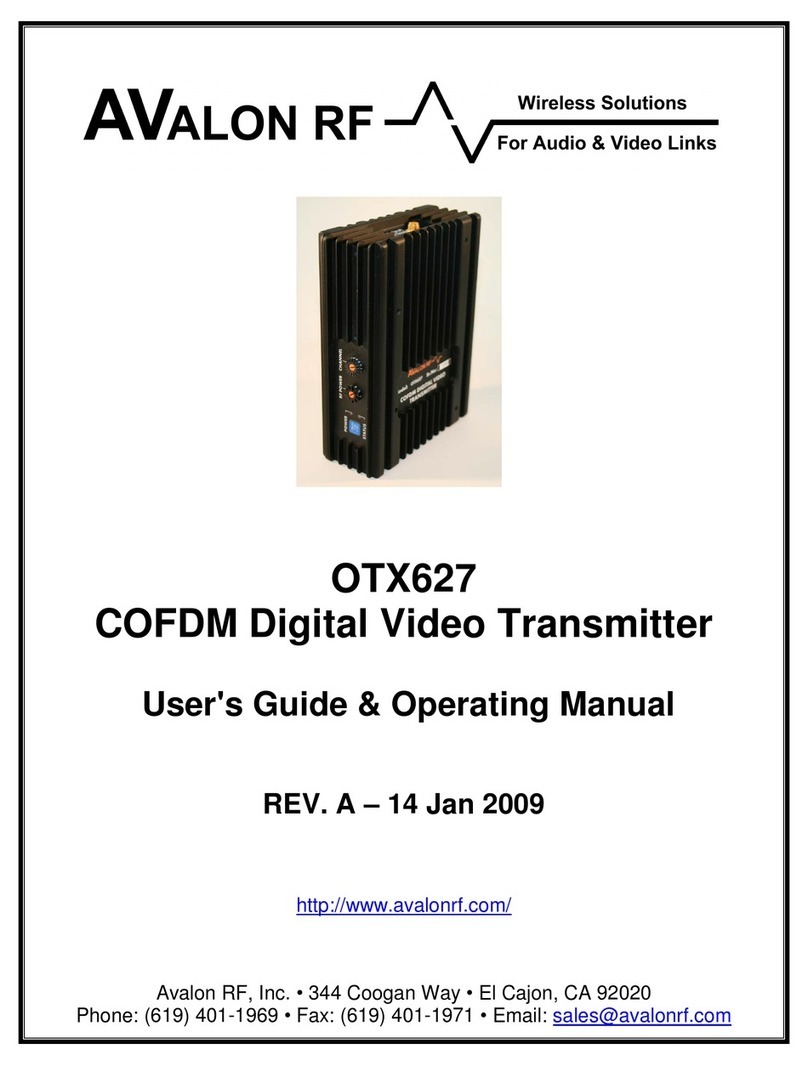
Avalon RF
Avalon RF OTX627 User's guide & operating manual
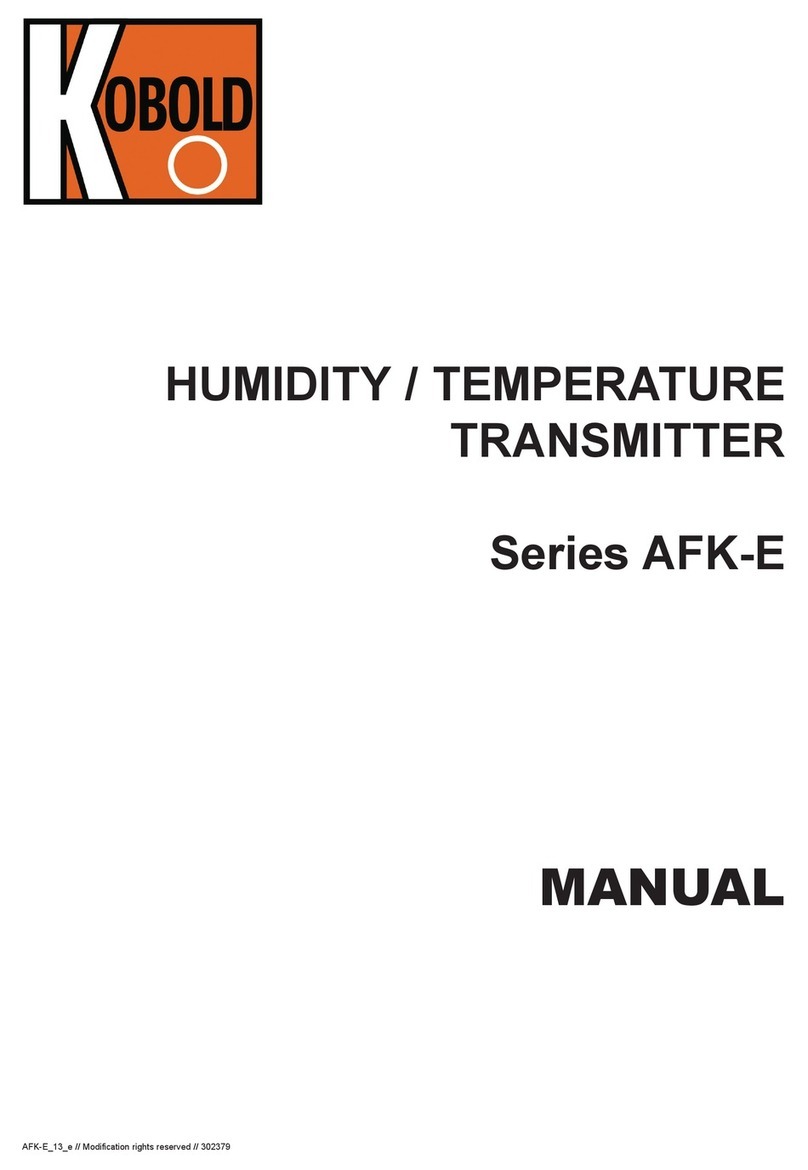
Kobold
Kobold AFK-E Series manual
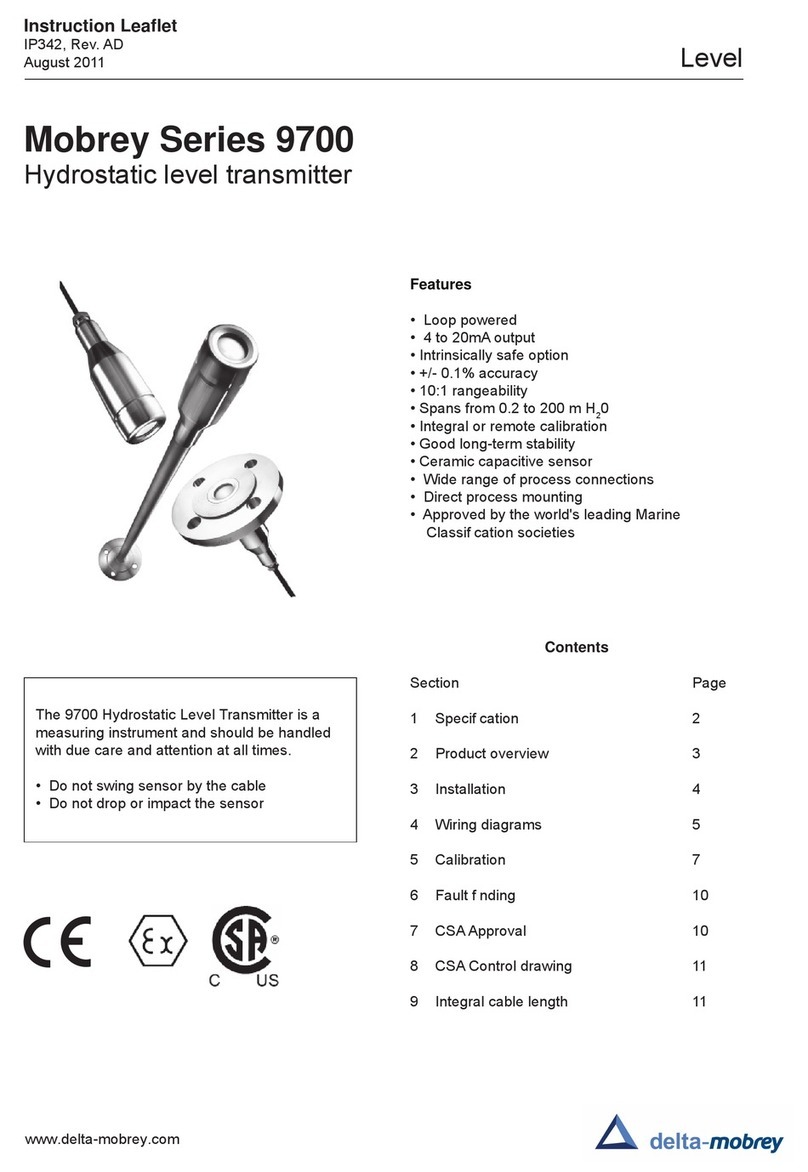
Mobrey
Mobrey 9700 Series Instruction leaflet
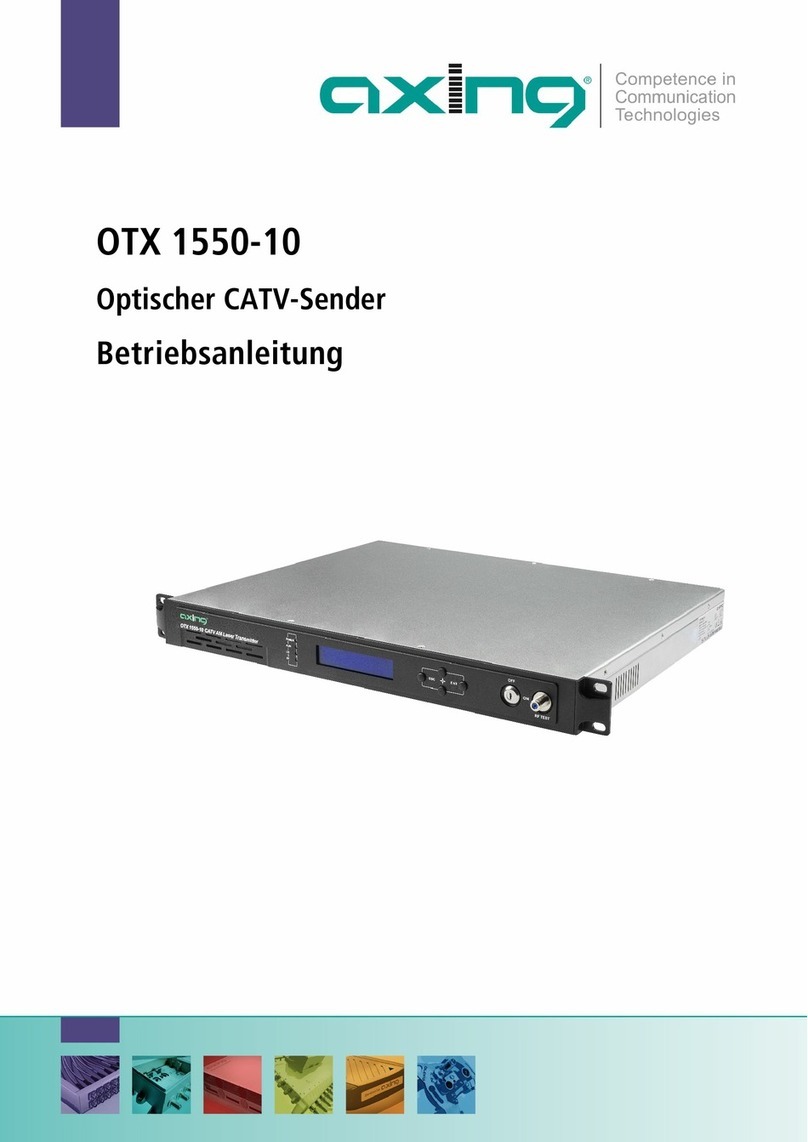
axing
axing OTX 1550-10 Operation instructions
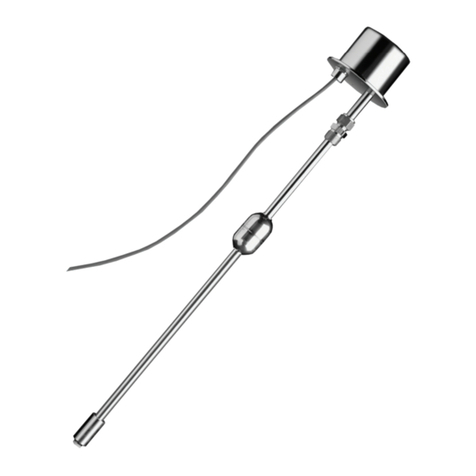
MTS Sensors
MTS Sensors Level Plus M Series Operation and installation manual
